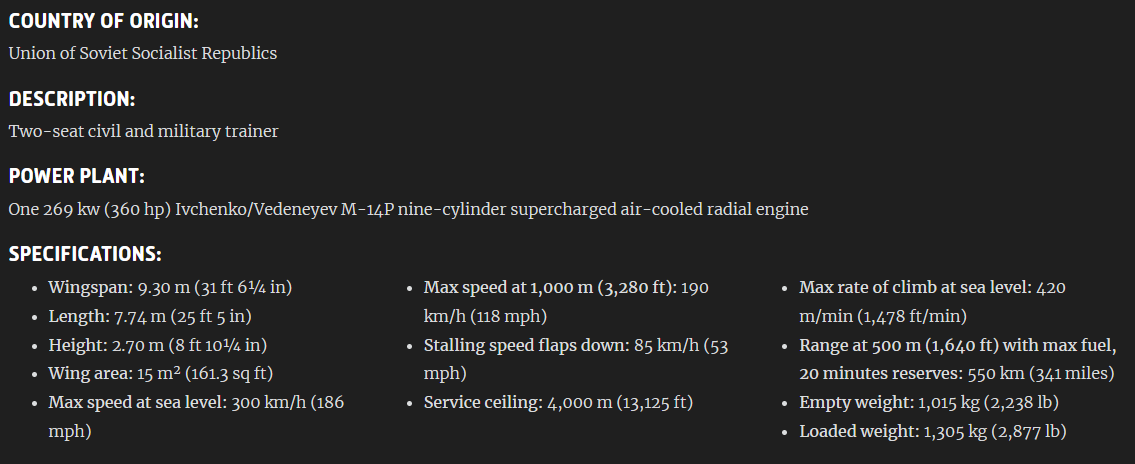Yak 52 – VH-UHO
Manufactured in 1984 in Romania, VH-UHO was first registered in Australia in 2006. The aircraft is powered by a Vedeneyev M14P nine cylinder 435 HP radial engine, and has a two bladed Whirlwind propeller.
Check out this information video about VH-UHO operating out of Bundaberg.
History
The Yak 50 was designed by Sergei Yakovlev and Yuri Yankevich as an improved aerobatic aircraft to succeed the Yak 18 series at the 1976 World Aerobatic Championships which were held that year in the city of Kiev in the Ukraine. Designed as a single-seater, the Yak 50 was smaller and lighter than the old aircraft and was fitted with a fan-cooled variant of the Ivchenko engine, this providing a superior power to weight ratio. With a rearwards retracting tailwheel undercarriage, it went on to prove its capabilities, taking the first two places in the men’s event, and the first five places in the women’s event.
In 1977 the Yak 52 appeared, being basically a two-seat variant of the Yak 50, with a semi-retractable tricycle undercarriage, the wheels being completely exposed. Stressed to +7 and –5G, as compared with +9 and –6G for the Yak 50, the Yak 52 was adopted as the standard trainer for the State-run flying clubs of the Soviet Union, which provided training for air force recruits and refresher training for reservists.
Later, production of the Yak 52 occurred at the Intreprinderia de Avione Bacau in Romania, which became known as Aerostar SA, where it was known as the Iak 52. Production in 1993 was known to be at the rate of 100 aircraft per year. A later Yak 53 single-seat aerobatic variant was subsequently produced by Yakovlev. By early 1993 more than 1,700 examples of the series had been produced, mainly for the Russian and Romanian Air Forces.
Structure was all-metal aluminium-alloy stressed-skin with steel reinforcement in high stress areas, primary control surfaces being fabric covered. Undercarriage was semi-retractable, fuel capacity was 122 litres (27 Imp gals), and a 0.20 m³ (7.06 ft³) baggage compartment was accessible from the rear seat. It was said the flying controls were responsive and powerful, the ailerons were light, it was stable and held a heading and height well, was rugged and reliable, and was built without compromise and with little regard for cost in a way that no western manufacturer could contemplate.
A variant proposed by Aerostar in the mid 1990s was called the Condor, a proposed westernised model developed to meet FAR Pt 23 certification with a 224 kw (300 hp) Textron Lycoming AEIO-540 engine. New-build Yak 52Ws were built by Aerostar in Romania with the Vedeneyev M-14P engine driving a three-blade Mulbauer propeller, with Hoffman and Whirlwind propellers being offered also. Hydraulic brakes were standard, with toe brakes in both cockpits and the control surfaces metal covered.It was fitted with Garmin Avionics.
In 1993 a Yak 52 and a Yak 50 were imported for a group in South Australia. Since then more than 35 Yak 52s have been registered in Australia and New Zealand, and the numbers have been increasing. A Yak 52 converted to tailwheel configuration with other modifications became VH-YGJ (c/n 802) at Serpentine, WA, being registered in the Experimental Category, and reffered to as an Amateur-Built Yakka.
In the United Kingdom the type has proved popular, with more than 45 examples registered. A group of ten owners in the UK has been involved in pylon racing on the airshow circuit.
Yak 52 Specifications

